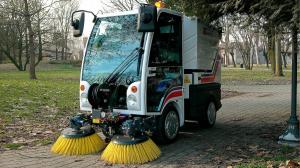Street Cleaning Machine Market Size to Worth USD 3.79 Billion by 2032 | CAGR of 5.4% during 2025-2032
Key Companies Covered in street cleaning machine Market are Roots Multiclean Ltd (India), Alfred Kärcher se co kg (Germany), Bortex Industries (Malta), & Others
The global street cleaning machine market is witnessing robust growth due to increasing urbanization, rising awareness about hygiene, and stricter municipal regulations for road cleanliness. In 2024, the market was valued at USD 2.51 billion and is projected to reach USD 3.79 billion by 2032. This reflects substantial market activity across various regions. Europe dominated the global market with a share of 39.04% in 2024. The market recorded the production of more than 55,000 units of street cleaning machines globally in 2023, with demand increasing year-on-year. Over 70% of municipalities in developed countries have upgraded their cleaning fleets with automated or semi-automated machines.
Get a Free Sample Research PDF: https://www.fortunebusinessinsights.com/enquiry/sample/111232
Key Findings for this Report
• Top Driver Reason: Growing need for hygiene and public sanitation in densely populated cities.
• Top Country/Region: North America recorded the highest adoption, with over 15,000 units sold in 2023.
• Top Segment: Sweepers accounted for over 65% of the total market share in 2024.
Key Street Cleaning Machine Market Companies Profiled
• Cleanland (India)
• Roots Multiclean Ltd (India)
• Alfred Kärcher SE & Co. KG (Germany)
• Bortex Industries (Malta)
• Schwarze Industries (U.S.)
• Tennant Company (U.S.)
• Hako Group (Germany)
• Atlas Industries (India)
• Bucher (Switzerland)
Top Companies with Highest Share
• Tennant Company (U.S.): With over 6,000 units sold in 2023, Tennant leads in innovation, offering a wide range of electric and autonomous machines.
• Bucher (Switzerland): Bucher holds a significant share in Europe, delivering over 5,500 machines last year, focused on modular and smart solutions.
Street Cleaning Machine Market Trends
The street cleaning machine market is evolving with the integration of electric mobility and autonomous systems. By 2024, more than 25% of newly manufactured machines were electric-powered, signaling a clear shift away from internal combustion engines. Autonomous machines are increasingly preferred for large-scale applications, especially in urban and industrial zones. Over 40 cities worldwide now use AI-enabled sweepers equipped with GPS tracking and pollution sensors. The trend towards low-noise, eco-friendly solutions is also notable, with noise emissions dropping below 60 dB in most new models. Compact machines that can access narrow lanes and sidewalks are gaining traction, particularly in Asian and European cities.
Street Cleaning Machine Market Dynamics
Drivers of Market Growth:
Rapid urban expansion and the growing number of vehicles on roads have significantly increased dust and debris in metropolitan areas. Over 60% of urban councils across high-density regions have mandated daily street cleaning routines. As a result, demand for fast, efficient, and easy-to-operate street cleaning machines has risen steadily. In 2023, over 45,000 street cleaning machines were deployed in cities with populations exceeding one million. Environmental concerns and the desire to improve urban aesthetics also fuel adoption.
Market Restraints:
Street cleaning machines, especially electric and multi-functional variants, often involve high upfront costs. The average price of a standard truck-mounted sweeper ranges between USD 150,000 to USD 250,000. Operational costs including fuel, maintenance, and skilled labor also contribute to budgeting concerns for local governments. In some regions, older infrastructure and lack of specialized workforce delay the deployment of modern machines.
Market Opportunities:
Automation and electrification present significant growth opportunities. Autonomous sweepers equipped with AI and LIDAR systems reduce dependency on human operators and improve consistency. In 2024, sales of autonomous cleaning machines increased by over 30% compared to 2023. Electric machines, supported by subsidies and incentives, are expected to dominate new purchases by 2027. Battery efficiency has improved by 40% in the last two years, allowing longer operating times on a single charge.
Market Challenges:
Despite the shift toward advanced technology, integrating street cleaning machines with smart infrastructure poses a challenge. Many cities lack the necessary connectivity, such as real-time monitoring systems or traffic coordination protocols. Incompatibility between old road designs and large cleaning vehicles limits their use in tight or heavily pedestrianized areas. Over 50% of urban road networks in older cities were not designed to accommodate large automated machines.
Connect with Our Expert for any Queries: https://www.fortunebusinessinsights.com/enquiry/speak-to-analyst/111232
Street Cleaning Machine Market Segmentation
The street cleaning machine market is segmented by product type, handling type, mode of operation, and application. Each segment reflects specific user needs and regional preferences.
By Product Type
• Sweepers: Sweepers dominate the market, accounting for over 65% of global demand. In 2024, more than 38,000 sweeper units were sold globally, primarily used for dry and wet sweeping in urban settings.
• Washers: Washers contribute to around 20% of the market. These machines are favored in regions with heavy dust pollution and are frequently used after construction work or during festival cleanups.
By Handling Type
• Walk-Behind Machines: Suitable for small-scale applications, walk-behind machines account for 18% of total units sold. Over 6,000 units were deployed in city parks and pedestrian zones in 2023.
• Ride-On and Truck-Mounted Machines: These machines, making up 72% of the market, are favored for highway and citywide cleaning. More than 30,000 truck-mounted machines were in active service globally by 2024.
By Mode of Operation
• Electric: Electric machines now represent over 25% of total production, with adoption growing fastest in Europe and Asia.
• Manual and ICE: Traditional models still hold 60% of the market, although their share is declining as emission norms tighten globally.
By Application
• Urban and Public Roads: This segment holds over 55% market share, with growing emphasis on pollution control and public hygiene.
• Highways: High-speed sweepers are widely used here, with over 9,000 units active globally in 2024.
• Transit Facilities: Railways and airports contributed to 12% of machine demand due to strict cleanliness standards.
• Others (Industrial Facilities): Used for large campus or industrial environments, these machines accounted for 8% of the 2024 sales.
Our Other Research Related Reports
Facilities Management Market Growth Rate, Size, Share 2025-2032
Construction Equipment Market Growth Rate, Size, Share 2025-2032
Ashwin Arora
Fortune Business Insights™ Pvt. Ltd.
+1 833-909-2966
sales@fortunebusinessinsights.com
Visit us on social media:
Facebook
X
LinkedIn
Legal Disclaimer:
EIN Presswire provides this news content "as is" without warranty of any kind. We do not accept any responsibility or liability for the accuracy, content, images, videos, licenses, completeness, legality, or reliability of the information contained in this article. If you have any complaints or copyright issues related to this article, kindly contact the author above.
Humor as Healing: The Usefulness of Hippopotamus Delivers Joy for Trying Times
Modernizing Whole-Home Entertainment Systems: Key Considerations for Today’s Homeowners
Austin Disaster Relief Network Provides Ongoing Relief and Long-Term Recovery Support Across Central Texas Flood Zones
Więcej ważnych informacji
 Jedynka Newserii
Jedynka Newserii

 Jedynka Newserii
Jedynka Newserii

Konsument

Grupa nowych biednych emerytów stale się powiększa. Ich świadczenie jest znacznie poniżej minimalnej emerytury
Przybywa osób, które z powodu zbyt krótkiego czasu opłacania składek pobierają emeryturę niższą od minimalnej. Tak zwanych nowych biednych emerytów jest w Polsce ok. 430 tys., a zdecydowaną większość grupy stanowią kobiety – wskazują badania ekspertów Instytutu Pracy i Spraw Socjalnych. W ich przypadku krótszy okres składkowy zwykle wynika z konieczności opieki nad dziećmi lub innymi osobami w rodzinie. Wśród innych powodów, wymienianych zarówno przez panie, jak i panów, są także praca za granicą lub na czarno oraz zły stan zdrowia.
Media i PR
M. Wawrykiewicz (PO): Postępowanie z art. 7 przeciw Węgrom pokazało iluzoryczność tej sankcji. Unia wywiera naciski poprzez negocjacje nowego budżetu

Przykład Węgier pokazał, że procedura z artykułu 7 traktatu o UE o łamanie praworządności nie ma mocy prawnej z powodu braku większości, nie mówiąc o jednomyślności wśród pozostałych państw członkowskich. Negocjacje nowego budżetu UE to dobry pretekst do zmiany sposobu części finansowania z pominięciem rządu centralnego. Czerwcowy marsz Pride w Budapeszcie pokazał, że część społeczeństwa, głównie stolica, jest przeciwna rządom Viktora Orbána, ale i na prowincji świadomość konsekwencji działań Fideszu staje się coraz większa przed przyszłorocznymi wyborami.
Firma
Blockchain zmienia rynek pracy i edukacji. Poszukiwane są osoby posiadające wiedzę z różnych dziedzin

Zapotrzebowanie na specjalistów od technologii blockchain dynamicznie rośnie – nie tylko w obszarze IT, ale również w administracji, finansach czy logistyce. Coraz więcej uczelni wprowadza programy związane z rozproszonymi rejestrami, które wyposażają studentów w umiejętności odpowiadające wymogom rynku.
Partner serwisu
Szkolenia

Akademia Newserii
Akademia Newserii to projekt, w ramach którego najlepsi polscy dziennikarze biznesowi, giełdowi oraz lifestylowi, a także szkoleniowcy z wieloletnim doświadczeniem dzielą się swoją wiedzą nt. pracy z mediami.


![Nestlé w Polsce podsumowuje wpływ na krajową gospodarkę. Firma wygenerowała 0,6 proc. polskiego PKB [DEPESZA]](https://www.newseria.pl/files/1097841585/fabryka-nesquik_1,w_85,r_png,_small.png)






.gif)

 |
| |
| |
|